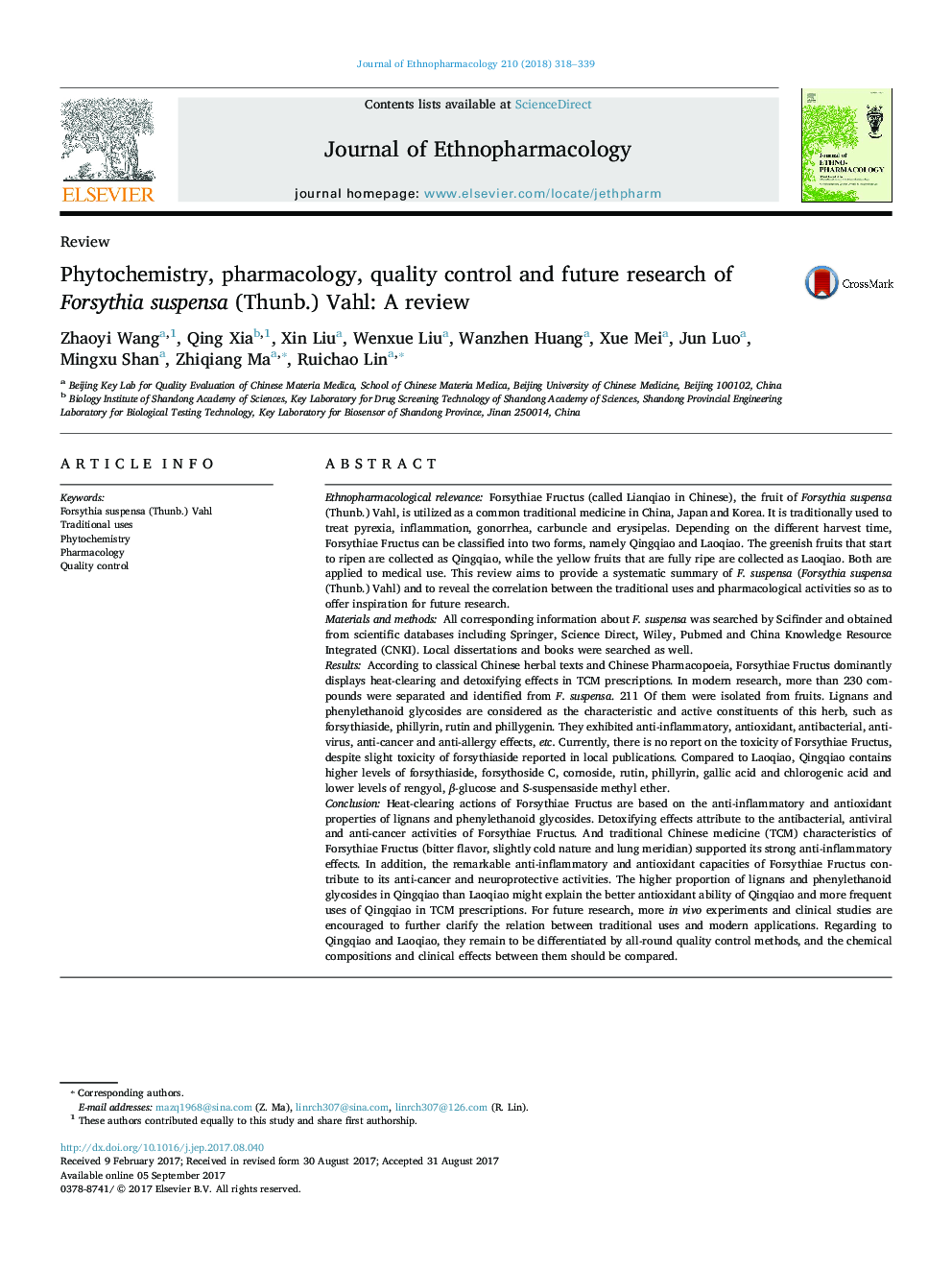| کد مقاله | کد نشریه | سال انتشار | مقاله انگلیسی | نسخه تمام متن |
|---|---|---|---|---|
| 5555925 | 1560352 | 2018 | 22 صفحه PDF | دانلود رایگان |

Ethnopharmacological relevanceForsythiae Fructus (called Lianqiao in Chinese), the fruit of Forsythia suspensa (Thunb.) Vahl, is utilized as a common traditional medicine in China, Japan and Korea. It is traditionally used to treat pyrexia, inflammation, gonorrhea, carbuncle and erysipelas. Depending on the different harvest time, Forsythiae Fructus can be classified into two forms, namely Qingqiao and Laoqiao. The greenish fruits that start to ripen are collected as Qingqiao, while the yellow fruits that are fully ripe are collected as Laoqiao. Both are applied to medical use. This review aims to provide a systematic summary of F. suspensa (Forsythia suspensa (Thunb.) Vahl) and to reveal the correlation between the traditional uses and pharmacological activities so as to offer inspiration for future research.Materials and methodsAll corresponding information about F. suspensa was searched by Scifinder and obtained from scientific databases including Springer, Science Direct, Wiley, Pubmed and China Knowledge Resource Integrated (CNKI). Local dissertations and books were searched as well.ResultsAccording to classical Chinese herbal texts and Chinese Pharmacopoeia, Forsythiae Fructus dominantly displays heat-clearing and detoxifying effects in TCM prescriptions. In modern research, more than 230 compounds were separated and identified from F. suspensa. 211 Of them were isolated from fruits. Lignans and phenylethanoid glycosides are considered as the characteristic and active constituents of this herb, such as forsythiaside, phillyrin, rutin and phillygenin. They exhibited anti-inflammatory, antioxidant, antibacterial, anti-virus, anti-cancer and anti-allergy effects, etc. Currently, there is no report on the toxicity of Forsythiae Fructus, despite slight toxicity of forsythiaside reported in local publications. Compared to Laoqiao, Qingqiao contains higher levels of forsythiaside, forsythoside C, cornoside, rutin, phillyrin, gallic acid and chlorogenic acid and lower levels of rengyol, β-glucose and S-suspensaside methyl ether.ConclusionHeat-clearing actions of Forsythiae Fructus are based on the anti-inflammatory and antioxidant properties of lignans and phenylethanoid glycosides. Detoxifying effects attribute to the antibacterial, antiviral and anti-cancer activities of Forsythiae Fructus. And traditional Chinese medicine (TCM) characteristics of Forsythiae Fructus (bitter flavor, slightly cold nature and lung meridian) supported its strong anti-inflammatory effects. In addition, the remarkable anti-inflammatory and antioxidant capacities of Forsythiae Fructus contribute to its anti-cancer and neuroprotective activities. The higher proportion of lignans and phenylethanoid glycosides in Qingqiao than Laoqiao might explain the better antioxidant ability of Qingqiao and more frequent uses of Qingqiao in TCM prescriptions. For future research, more in vivo experiments and clinical studies are encouraged to further clarify the relation between traditional uses and modern applications. Regarding to Qingqiao and Laoqiao, they remain to be differentiated by all-round quality control methods, and the chemical compositions and clinical effects between them should be compared.
330
Journal: Journal of Ethnopharmacology - Volume 210, 10 January 2018, Pages 318-339